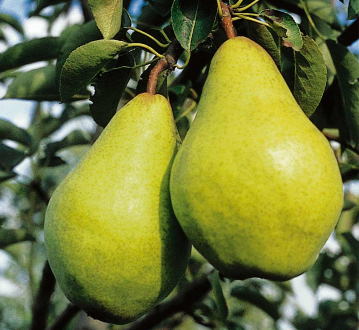
- Williams pear belongs to the Rosaceae family, genus Pyrus, species communis (Chagné, 2014).
- Originally from Asia, the pear tree has been established in France since time immemorial. Today, 2,000 varieties are listed, including the Williams pear, a summer fruit born dating back to 1796 (Centre national de pomologie d’Ales, 2010).
Physical and organoleptic characteristics
- Pear tree flowers are white to whitish-pink with five petals and are often mistaken for apple tree flowers. In the autumn, the edible fruit, 6.5 to 10 cm long, ripen to a green to brown colour (Andreu, 2008). The pear is harvested when its skin becomes dark green to light green in colour (Nath, 2012). Like avocados or kiwis, it needs a few days after harvest to ripen (Murayama, 2006).
- The two esters (ethyl (E, Z) -2,4-decadienoate and ethyl (E, E) -2,4-decadienoate) are responsible for the typical Williams pear odour, while hexyl acetate provides the aroma (Zierer, 2016).
- The sugar content in Williams pears varies from 8 to 11% with fructose as the main sugar (Chatfield and McLaughlin, 1928). The impact of sugar is affected by the juiciness of the fruit: the juicier the fruit, the sweeter the taste (Visser, 1968).
- The resistance of its strong aromatic compounds to heat may explain the use of the Williams variety in the manufacture of canned pear and pear brandy (Quamme, 1985).
- There are yellow and red varieties of Williams pears. The expression level of the PcMYB10 gene is significantly higher in the red variety than in the yellow variety. This gene is involved in the biosynthesis of anthocyanins, the polyphenols responsible for the red colour of the fruit (Pierantoni, 2010).
Composition characteristics (excluding macronutrients, vitamins and minerals)
- Their high fibre concentration probably explains the laxative properties of pears and their effect on gut health (Reiland, 2015).
- An American team observed a high content of total polyphenols in Williams pear skin extracts, as well as antioxidant free radical scavenging activities related to 2,2 diphenyl-1-picrylhydrazyl (Sarkar, 2015). Among these phenolic compounds, isorhamnetin glycosides and malonates are thought to represent a significant amount (Lin, 2008).

